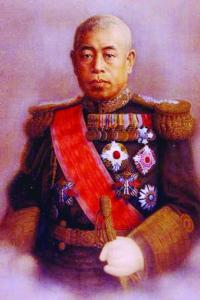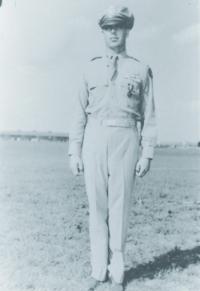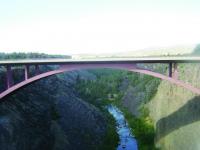
Admiral Isoroku Yamamoto

P-38 Lightnings

Rex T. Barber, credited with shooting down Admiral Yamamoto's plane.

Rex T. Barber Veterans Memorial Bridge in Oregon.
Admiral Isoroku Yamamoto, Commander-in-Chief of Japan's Combined Fleet and architect of the Japanese attack on Pearl Harbor, was killed when his plane was shot down by US Army Air Forces on April 18, 1943. Yamamoto's death was significant in that it represented a loss, to Japan, of its most skilled and revered naval tactician. For the United States Navy in the Pacific, Yamamoto's death, sixteen months after Pearl Harbor, boosted morale and was seen as a capstone to the increasingly hard-fought naval campaigns and victories against the Japanese Navy.
Admiral Yamamoto's career began as a naval cadet during the Russo-Japanese War. The war began in 1904, after the Japanese successfully conducted a surprise attack on the Imperial Russian Navy, and ended at the epic Battle of Tsushima in 1905, where Yamamoto witnessed the Russian defeat. The Japanese proved to be a major naval power and Yamamoto began his career in earnest to do his part in sustaining that legacy.
Yamamoto soon proved himself to be a skilled naval tactician and commander with the respect of his subordinate sailors. He devoted himself to the study of naval theory and strategies, viewing the United States Navy as the best example of a modern worldwide naval power. Yamamoto spent some time in the United States, backpacking across the country. He studied at Harvard University between 1919 and 1921, twice served as naval attaché in Washington, D.C., and attended the U.S. Naval War College. With fleet command, Yamamoto participated in the London Naval Conferences of 1930 and 1934.
In the late 1930s, Yamamoto, who disagreed with the traditional view that the Navy should function primarily to support Army missions, publicly opposed several Japanese combat actions, viewing them as either not in Japan's best interests, or serving the best function of its navy. Moreover, Yamamoto was acutely aware of the political ramifications of any Japanese action which could potentially evoke a negative reaction by the United States. Though the United States, during the earlier period of interregnum, was largely isolationist, Yamamoto knew that if provoked, the United States would react strongly against any diplomatic or military threat. These opinions caused Yamamoto to be the recipient of assassination threats by the more hawkish military elite. Yamamoto was promoted to Commander-in-Chief of the Combined Fleet in 1939, in part to protect him from such threats at home by sending him out to sea with the fleet.
It was clear to Yamamoto by the middle of 1940 that Japan would soon be in a war with the United States. Now in charge of the Navy, Yamamoto had serious reservations about the war, most notably that should it last too long, the industrial capacity and oil supply of the United States would eventually outpace and overpower Japan. Yamamoto took a radical strategic step that he hoped would, if successful, shorten the war to Japan's advantage. Yamamoto's design called for a preventive strike (Pearl Harbor) which would reduce U.S. naval forces, followed shortly by a "Decisive Battle" (Battle of Midway) which would further reduce both the enemy forces and morale. In mid-1941 Yamamoto famously described the potential war with the United States: "I shall run wild considerably for the first six months or a year, but I have utterly no confidence for the second or third years."
Though the Pacific Fleet was badly damaged at Pearl Harbor, the three U.S. aircraft carriers, and other capital ships survived. Yamamoto, who as early as 1924 viewed the future of naval power as necessarily linked to air power, determined that the failure to destroy the carriers at Pearl Harbor to be a significant omen. In the coming months, the U.S. Pacific Fleet, commanded by Admiral Chester Nimitz, would see hard-fought naval victories. The plan for Japan's victory in a "Decisive Battle" would fail, in part because U.S. cryptographers, after breaking the Japanese naval code, learned, in advance, Japan's battle plan. The Battle of Midway, in June 1942, ended in a tremendous Japanese defeat, the result of which reduced the Japanese naval ability to defensive actions only. At Midway, Japan lost four of six fleet carriers and thousands of sailors. With its enemy no longer pursuing major offensive actions, the United States Navy mostly controlled the script of the remaining campaigns of the Pacific Theater. While the United States Navy continued to add capital ships and sailors to its fleet, the Japanese Navy struggled to replace, repair, and resupply its fleet as the war progressed.
On April 13, 1943, U.S. code breakers intercepted a Japanese message which detailed Admiral Yamamoto's plans to fly from the Japanese base of Rabaul, on the island of New Britain, to the island of Bougainville, on April 18 where he would meet with wounded Japanese soldiers. Though some Japanese radiomen were hesitant to send such a detailed message, others ultimately decided that since the Japanese naval codes had been changed on April 1, they were confident in the message's security. So detailed was the message intercepted by U.S. intelligence that it included not only the exact number and types of planes in which Yamamoto and his escorts would travel, but also the specific tail numbers of each plane, and a precise time of departure and arrival.
Immediately upon intercepting the message, U.S. intelligence forces knew they had something big, but what precisely to do with such information was met with ethical considerations. One debate was whether using such information to target Yamamoto, specifically, was ethical. Dissenters argued the act was akin to assassination rather than combat. Another consideration was that if not handled properly, offensive action against Yamamoto and his escorts would make obvious to the Japanese that the U.S. had indeed broken their naval code. Ultimately it was President Roosevelt who decided that the mission against Yamamoto and his convoy was a military operation, not political. President Roosevelt understood that Yamamoto, a high value tactician with few equals, could not easily be replaced.
The operation was designed to look like a training exercise in which aviators during their flight would happen upon and engage enemy aircraft. Though they knew not the specific identity of their target, the pilots were informed they were to engage an "important high officer." To be sure, the highly trained and experienced U.S. pilots easily outmatched Yamamoto's convoy. A total of eighteen Army P-38 Lightnings intercepted the convoy. Yamamoto was killed by aircraft gunfire, and his plane crashed in the jungle. Japanese engineers found Yamamoto's wreckage the next day and falsely reported that the revered admiral was still erect in his chair, heroically grasping the hilt of his sword. Coincidentally, the death of Yamamoto was exactly one year after the famous "Doolittle Raid" on Tokyo. Though the Japanese tried to assign a heroic tone to the Admiral's death, the loss of Yamamoto was ultimately felt throughout the empire. It was obvious to many that the Pacific War, by this time, though still violent, was much in the U.S. favor. For the United States Navy, Yamamoto's death seventy years ago further cemented its resolve and greatly assisted in ending the Pacific War.
NEXT: KATYÑ
«Go back to the previous page.



